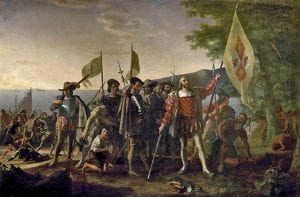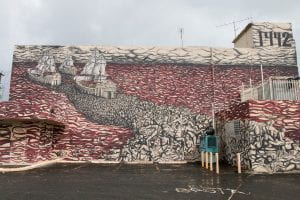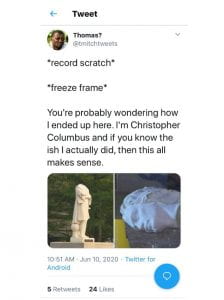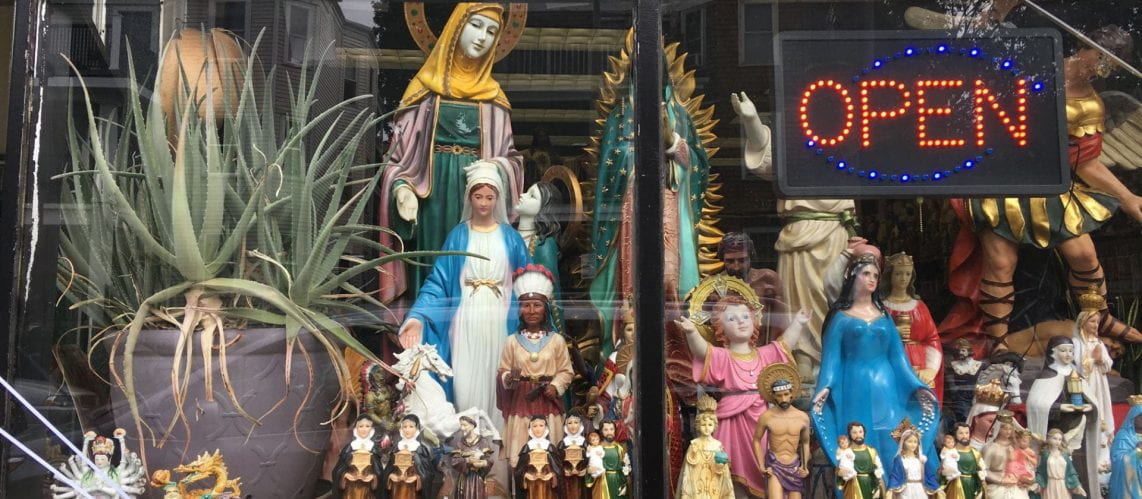By Lauren R. Kerby
Lauren R. Kerby is the education specialist for the Religious Literacy Project and a lecturer on religious studies at Harvard Divinity School.
This lesson uses two different images of Christopher Columbus to challenge students to move beyond how they may have been taught to think about violence and peace. It asks them to identify cultural violence and cultural peace in images that may challenge what they think of as violent or peaceful. This lesson presumes students have been introduced to Johan Galtung’s theory of cultural violence and peace.
Discussion Prompts
- Surfacing assumptions
Ask students to draw what comes to mind when you say “the landing of Columbus.” Share and discuss their images in pairs and/or the full group, and ask where their ideas of these images come from.
- U.S. Capitol Painting
Share with students the first image of Christopher Columbus, the painting by John Vanderlyn that hangs in the U.S. Capitol Rotunda. Discuss what stands out to them about the image itself, and consider also what message the U.S. government sends by hanging this image at the center of American government.

- San Juan Mural
Share with students the second image of Christopher Columbus, the mural 1492 from San Juan, Puerto Rico. Again, discuss what stands out to them about the image, and consider what the artist’s aims were.

- Cultural Violence and Peace
Ask students to reflect on whether each image is an example of cultural violence or peace. If more scaffolding is needed, propose to students that one (the Capitol image) is an example of cultural violence, and the other (San Juan) is an example of cultural peace, and ask them to discuss why.
This may seem counterintuitive to students, since the Capitol image is “peaceful.” Columbus’ triumphant stance goes unopposed by those around him, and the natural landscape around the group is idyllic. In contrast, the San Juan mural depicts the three Spanish ships departing the New World, leaving a wake of dead bodies in a sea blood, under a cloudy sky. It is a gruesome scene, one many students may wish to call violent.
We (the RLP) argue that the painting in the US Capitol is cultural violence because it glorifies Europeans’ colonization of the Americas and erases the oppression of indigenous peoples. We argue that the San Juan mural is cultural peace because it reveals the violence that took place in the landing of Columbus and subsequent colonization.
We tend to think that violence must be ugly, and peace must be beautiful. This is simply not the case. Using Galtung’s lens, we can see that cultural violence can be beautiful. It can hang in prominent places. To achieve cultural peace, we must look beyond that superficial beauty, the illusion of peace. We need to see the structural and direct violence that lurk beneath it. The work of cultural peace is not always beautiful or comforting. It is more likely to be found on the street than in the halls of power. But without it, we cannot even see direct and structural violence, much less work to build peaceful alternatives.
- Further Questions
Ask students to consider other forms cultural peace might take, whether in art or elsewhere. They might consider another familiar image or story and think about how they would revise it. (Hamilton is a great example here of cultural peace responding to white supremacy in American historical narratives.) They might also consider the summer 2020 debates in the U.S. about removing statues of Columbus and how thinking about cultural violence and peace might shift how we understand those statues.

Connections
What follows are suggestions for helping students connect this lesson to examples of cultural violence and peace that are more immediate.
- Black Lives Matter and All Lives Matter
As with the images of Columbus, students may be inclined to say ALM is cultural peace, in this case because it is more inclusive. However, the purpose of BLM is to draw attention to the ways in which Black lives have not mattered in American society. It reveals direct and structural violence. In contrast, All Lives Matter erases the reality of systemic racism in the United States, and as such is an example of cultural violence.
A similar conversation structure as that described above can be used with these examples.
- Contemporary Images of Cultural Violence and Peace
Students could also consider two images of a current event that similarly illustrate serene cultural violence and chaotic cultural peace.
- Experiential Learning
Depending on the teaching context and factors like support or resistance from parents and administrators, teachers may ask students to identify a local example of cultural violence and brainstorm what cultural peace might look like in response. Art and memorials provide opportunities for this, but so do school course catalogs (whose history, art, language, or culture is featured?), school or community PR materials, and advertising.

